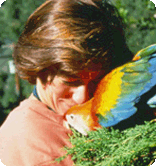Overgrown beak - to file or clip?

What is the best way to shorten an overgrown Amazon’s beak? file or clip?
Thanks, Diane

Hi Diane, Thanks for writing World Parrot Trust with an interesting question. At first, I thought it was a trick question because my immediate response is “neither”. Simply put, filing and clipping are not good remedies to beak overgrowth. In my experience, it’s abnormal to have overgrown beaks, so I’d recommend that you determine the reason for beak overgrowth and solve the situation there first. “Beak trimming is not necessary in birds unless the beak is overgrown due to underlying health problems or malocclusion,” states Greg Harrison, DVM, Dipl ABVP-Avian, Dipl ECAMS in Clinical Avian Medicine, Volume I, pg14.
Perhaps photos would help determine if your Amazon’s beak is abnormal or if a cosmetic enhancement is sought? If photos are available, please send them. With cosmetic situations (e.g., those that don’t stem from a physical malady), where the beak might just be rough and slightly uneven around the edges, chewing wood is the answer. We find that giving our Amazons lots of pine to chew up and consistently fresh wooden perches are the best beak grooming tools. Also, eating whole foods they sink their beaks into (vs eating little desiccated pieces of pellet, for instance) motivates parrots to vigorously wipe the juices off their beaks onto their perches and this wiping contributes to a well-groomed beak.
A healthy Amazon, given soft woods to chew and barky, fresh branches for beak wiping, will keep his or her beak well-groomed without intervention. If your bird’s situation is different, kindly explain more fully.
Compare your parrot’s beak to the beaks of Amazons you see on this web site. Shaping beaks is best left to experts with good tools who know how to use them. Also, remember that restraint alone can be stressful and incompetent restraint is worse. Under restraint, one wrong jerk by either the bird or practitioner could mean pain for the bird and additional beak trauma.
All best,
Phoebe Greene Linden
Santa Barbara Bird Farm

































